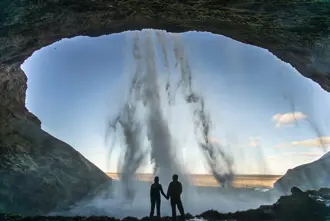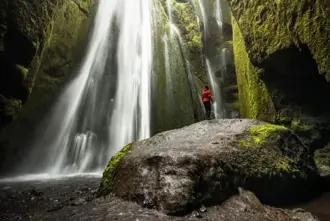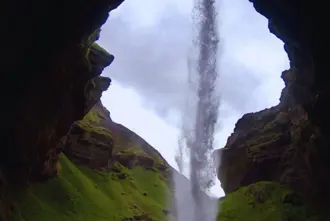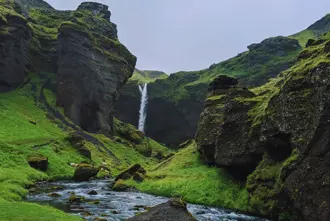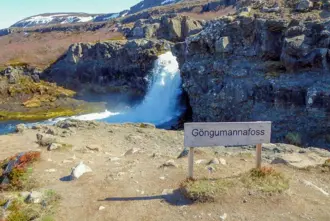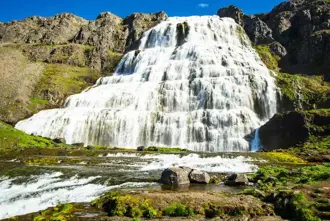One of the most magical things you can do in Iceland is walk behind a cascading waterfall. Most people will know about Seljalandsfoss the iconic walk-behind waterfall in the south. What most visitors don't know is that Gljúfrabúi, Kvernufoss, also in the south, and Göngumannafoss located in the Westfjords, are also waterfalls you can walk behind and well worth the visit.
That makes it at least four of these special kinds of waterfalls in Iceland; the waterfalls you can walk behind.
Maps of Icelandic Waterfalls to walk behind
Seljalandsfoss
Seljalandsfoss is the most famous of Iceland’s walk-behind waterfalls. Located along the South Coast, just off the Ring Road, it’s one of the first major sights travelers encounter when heading east from Reykjavik. The waterfall drops 60 meters (197 feet) from a tall cliff, forming a near-perfect curtain of water. A well-maintained footpath circles around the back, allowing visitors to step behind the falling water into a naturally carved-out alcove.
The path behind Seljalandsfoss is wide and relatively easy to walk on during summer, but the spray from the waterfall keeps it wet year-round. Expect to get soaked if you go all the way around. If you visit in winter, the path can be treacherous with ice. Sometimes it is closed for safety reasons, so always check conditions before attempting to walk behind it. For those who make it, the view from behind the waterfall is unforgettable, especially at sunset when the light reflects off the cascading water.
- GPS Coordinates of Seljalandsfoss: 63°36'56.2"N 19°59'19.0"W
Join us on a Walk behind Seljalandsfoss
Gljúfrabúi
Just a short walk north of Seljalandsfoss is a hidden gem called Gljúfrabúi. Unlike its famous neighbor, Gljúfrabúi is partially enclosed by a cliff, making it almost invisible from a distance. The only way to reach it is by stepping into a small stream and wading through a narrow opening between rock walls. Once inside, the view is magical. Water rushes down from above into a small pool, and the rock walls form a sort of secret chamber.
Because of the confined space, visitors get completely drenched from the mist and splash of the waterfall. Waterproof clothing is a must. The rocks inside are also very slippery, so stepping carefully is important. Gljúfrabúi offers a completely different experience from other waterfalls, giving visitors the feeling of stepping into a hidden world.
A pair of waterproof boots with a god grip is a must here.
- GPS Coordinates of Gljúfrabúi: 63°37'15.9"N 19°59'11.0"W
Walk behind Seljalandsfoss on a 7 Day Journey of Iceland
Kvernufoss
Further along the South Coast, near the famous Skógafoss, lies Kvernufoss, a lesser-known but equally stunning waterfall. It requires a short hike— about 15-20 minutes from the parking lot near the Skógar Museum. The trail is easy to follow, winding through green hills before revealing the 30-meter (98-foot) waterfall tucked inside a small canyon.
The path behind Kvernufoss is narrower than the one at Seljalandsfoss but still manageable for most visitors. The curved rock overhang gives an incredible perspective of the waterfall from behind, with views looking out toward the canyon entrance. Since it’s not as famous as Seljalandsfoss, it tends to be far less crowded, making it a peaceful and intimate experience. However, the path behind Kvernufoss can be muddy and slippery, especially after rain, so good hiking boots are recommended.
- GPS Coordinates of Kvernufoss: 63°31'44.4"N 19°28'48.9"W
Join us on a Walk behind Seljalandsfoss
Dynjandi - Göngumannafoss
Dynjandi, the jewel of the Westfjords, is a massive multi-tiered waterfall that cascades down a mountainside like a bridal veil. While most people come to see Dynjandi itself, one of its smaller waterfalls, Göngumannafoss, offers the unique chance to step behind the water.
Göngumannafoss is located along the trail leading up to Dynjandi, and while it’s not as towering as the main waterfall, it has a beautiful, delicate flow. The space behind it is quite small, so only a few people can fit at a time. Because of its location in the remote Westfjords, far fewer visitors make it here compared to the South Coast waterfalls. The trail up to Göngumannafoss and beyond is rocky and uneven, so sturdy shoes are essential. The experience of walking behind the water, with the powerful roar of Dynjandi in the background, makes it a memorable stop.
The hike up to Dynjandi from the parking lot is a short one - about 15-20 minutes. Although, taking a bit more time to stop at the other smaller waterfalls along the way is recommended. The elevation is only about a 100 meters (33 feet) so the hike is considered an easy one.
- GPS Coordinates of Göngumannafoss: 65°44'07.4"N 23°12'15.5"W
- GPS Coordinates of Dynjandi waterfall: 65°43'57.3"N 23°11'55.2"W
Safety and caution
Walking behind waterfalls is absolutely magical but can also be dangerous. The paths are almost always slippery because the constant mist of water makes these areas the optimal habitat for moss and algae living on the rocks. Because of the water and the sometimes wading required paths might suggest it be a good idea to bring a pair of rubber boots, but because of the slippery nature it's a much better idea to bring waterproof hiking boots with good grip.
In winter, ice accumulates on these paths, making them hazardous pathways. Some of the paths will be shut off if conditions are too treacherous, so make sure to check first, especially if planning on seeing Seljalandsfoss or Kvernufoss. Don't take the chance if the ground is too slippery. Slips and accidents occur annually when individuals miscalculate how slippery areas like that can actually be.
Another important consideration is wind. The unstable weather of Iceland means that strong winds can blow the spray of the waterfall right into your face. It is especially frequent at Seljalandsfoss, where wind can shift directions abruptly, making what is already a wet experience that much wetter. A water-repellent jacket is called for, and bringing along dry clothing is also advisable.
Finally, always have respect for nature. The pathways behind waterfalls are natural, and there is also erosion to watch out for. Follow designated pathways, stay off of unstable rock, and do not attempt to hike behind waterfalls that have no designated pathways. The beauty of Iceland is best enjoyed responsibly, keeping safety your top priority.
Walk behind Seljalandsfoss on a 7 Day Journey of Iceland
Which waterfall can you walk behind in Iceland?
Seljalandsfoss is the best known walk-behind waterfall in Iceland, however, Gjúfrabúi and Kvernufoss, also located in the south, and Göngumannafoss located in the Westfjords close to Dynjandi waterfall, are also walk-behind waterfalls well worth a visit if you're looking for something a little less crowded.
|
|
Seljalandsfoss
|
Gljúfrabúi
|
Kvernufoss
|
Göngumannafoss
|
|
Height (m/ft)
|
60 m (197 ft)
|
40 m (131 ft)
|
30 m (98 ft)
|
Unknown (Part of Dynjandi)
|
|
Parking
|
Paid
|
Paid
|
Paid
|
Paid
|
|
Visitor Fee
|
Free
|
Free
|
Free
|
Free
|
|
Parking to Waterfall
|
100 m (0.06 mi) / 2 min
|
500 m (0.3 mi) / 10 min
|
1.2 km (0.75 mi) / 20 min
|
Varies / Along Dynjandi trail
|
|
From Reykjavík
|
120 km (75 mi) / 2 hrs
|
120 km (75 mi) / 2 hrs
|
150 km (93 mi) / 2.5 hrs
|
400 km (250 mi) / 5-6 hrs
|
|
Bathroom
|
Free
|
Free
|
Free
|
Free
|
Sources:
- World Waterfall Database. (n.d.). Kvernufoss. Retrieved from https://www.worldwaterfalldatabase.com/waterfall/Kvernufoss-14578
- World Waterfall Database. (n.d.). Seljalandsfoss. Retrieved from https://www.worldwaterfalldatabase.com/waterfall/Seljalandsfoss-19104
- World Waterfall Database. (n.d.). Göngumannafoss. Retrieved from https://www.worldwaterfalldatabase.com/waterfall/G%C3%B6ngumannafoss-25249
- World Waterfall Database. (n.d.). Gljúfrafoss. Retrieved from https://www.worldwaterfalldatabase.com/waterfall/Gljufrafoss-14438

